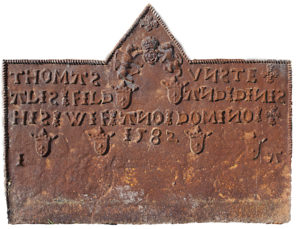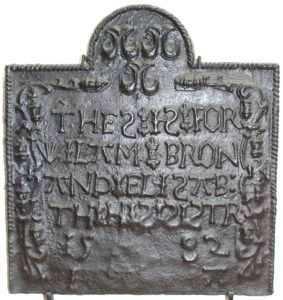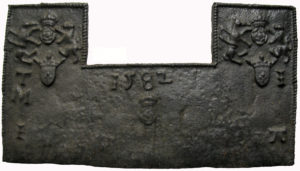There is a small group of firebacks that were all cast in the same year, 1582, and on three of them there are lengthy, personal inscriptions that were formed in a sand mould by impressing individual letters. Below the main text on each of them are the letters I and A, which it can be assumed were those of the person, probably the founder, who assembled the design. Whoever IA was their level of literacy was some way from being perfect, but to my eyes that is part of the charm of these ancient artefacts. Unfortunately, at the time of first writing this, I had only been able to record two of these firebacks in person. My knowledge of two more rested solely on illustrations that Mark Antony Lower included in his pioneering paper on the Wealden iron industry that was published in the Sussex Archaeological Collections in 1849. To his great credit, they are well drawn and a comparison between the detail on the drawings and on the two firebacks I had seen made it clear that they are all from the same series.

This is the first of the two in Lower’s paper. Drawn by F. F. Figg, the inscription had been copied as THOMAS VNSTE ADIS FILD AND DINIS HIS WIF ANO DOMINO 1582. Each letter S is reversed, as is each letter N although the latter form was not unusual in those days. The fireback was said to have been at ‘Misfield Farm’ in Worth, Sussex, near where I live. This should be Miswell, but enquiries there failed to locate it. Nor had I been able to trace any record of a Thomas or Denise Unstead of Isfield. So the trail seemed to have gone cold.

It has turned out that looking for a Thomas and Denise Unstead was a false trail because in January 2024 I received an email from a correspondent in Yorkshire telling me of an article in the Journal of the Gwynedd Family History Society that had revealed that the fireback had been discovered ten years earlier walled up behind a later fireplace in a hotel near Ffestiniog in north Wales. The photograph of it reveals that the inscription in Lower’s illustration had been copied incorrectly and that it should read THOMAS VNSTE ALIS FILD AND DINIS HIS WIF ANO DOMINO 1582. My correspondent had interpreted this as Thomas Anstie alias Field, with which I was happy to agree (the surname Anstye or Anstie occurs in Sussex in two forms with aliases, Field and Holcomb). And I have been able to identify them as probably Thomas Anstye and Denys Joyner who were married at Wivelsfield in Sussex on 5th June 1564. My conclusion that this fireback was one of a series with three others of the same date because it also bore the initials IA, a crowned Tudor rose supported by a dragon and a lion, and four, small crowned shields each bearing a fleur-de-lys, has, I am pleased to write, been confirmed.

Those same badges decorate the only fireback in the series that does not have an inscription, apart from the additional initials TM and I, which are probably those of whoever the fireback was made for. It is in the Haslemere Museum and its unusual shape meant that it was probably intended to fit into a specific fireplace. The small crowned shields, the rose and crown and supporters and the I and A are clearly the same as on the Anstie fireback.

The descriptive caption that used to be placed below this fireback on display in the Victoria & Albert Museum, in London, claimed that the water bougets, the three heraldic devices in the arch at the top, indicated that it was connected with the Ross family of Helmsley in North Yorkshire. However, the presence of the date 1582 in the same form as on the Haslemere back, as well as the I and the A, strongly suggested that it is also from this series and therefore cast in south-east England. The inscription reads: THES IS FOR WILAM BRON AND ELISABTH HIS SISTR. Who they were I have yet to find out, but the shape of the letters and in particular the tiny fleurs-de-lys between the words, also seen on the Anstie back, reinforces this view. The mirrored tassel design on each side is curious. It was evidently mounted on a flat surface but I have not seen anything like it elsewhere. Incidentally, there were Sussex families whose arms included water bougets: the Roos or de Ros family of Easebourne, near Midhurst, and the Meeres family of Glynleigh, near Hailsham. The V&A caption has since been amended.

Lower illustrated the fourth fireback in this series and also drew it. The same decorated devices seen on the other firebacks are present: the crowned rose and supporters, a single shield with fleur, the fleur word separators, the date and I and A. Also there are two, star-shaped arrangements of rope lengths with fleur terminals. The inscription is: THES IS FOR IAMES HIDE AND ION HIS WIF. When Lower published this drawing the back was at Sutton Hurst, later Sutton Hall, a house in Barcombe, Sussex, and a photograph from some sale particulars of the house in 1893 shows the fireback still there, in the hall fireplace; alas, neither the house nor the fireback are there any more.

We do know something of the people mentioned on this back. A James Hyde married Joan Blackefane in the church at Horley in Surrey on the 11th of October 1579. They went to live across the county boundary in Worth, then the largest Sussex parish and when, nearly 40 years later and ‘sick in body but in good remembrance’, James Hyde made his will in May 1617 he left legacies to his two sons, Benjamin and Henry, and his three daughters, Mary, Joan and Elizabeth, as well as to his 12 grandchildren. The rest of his estate went to his wife Joan who survived him. I do not know where in Worth their house was but presumably their fireback stood prominently at the rear of their main fireplace. James Hyde was buried at Worth church on 27th January 1618 Old Style*.
If anyone who reads this knows of the whereabouts of the fireback previously at Sutton Hurst/Hall, or any others that might be from the same series (or any other firebacks, come to that) I would be delighted to hear from them. There is a link to my email address on the Home Page of this website.
POSTSCRIPT:
I chanced upon the following brief reference to a fireback being offered for sale.

Although incorrectly described as wrought iron, I wonder to which of the three above it referred?
*Old Style: Before 14th September 1752 Great Britain used the Julian Calendar and before 1752 the New Year began on 25th March, so dates from 1st January until then were written as in the previous year; thus if the Gregorian Calendar which we use now had been in use on 27th January 1618 it would have been written as 27th January 1619.

